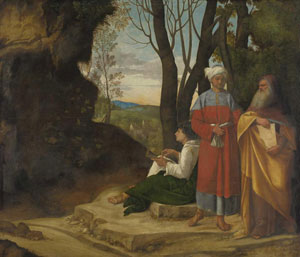2.5.24 — Philosophical Enough
To pick up from last time on “Bellini and Giorgione in the House of Taddeo Contarini” at Frick Madison, the paintings faced each other, as curated by Xavier F. Salomon, as if the wall across from Bellini’s had been waiting all along for a companion. Marcantonio Michiel saw them both at the house of Taddeo Contarini as well.
 It is his account that gave Giorgione’s its attribution and its name—and there the mystery begins. Attributions to this artist have long been all over the map, and not all historians accept this one. My old textbook does not so much as mention it. If I accept it, it is in no small part because a mere imitator would have smoothed over its enigmas.
It is his account that gave Giorgione’s its attribution and its name—and there the mystery begins. Attributions to this artist have long been all over the map, and not all historians accept this one. My old textbook does not so much as mention it. If I accept it, it is in no small part because a mere imitator would have smoothed over its enigmas.
Michiel notes that it took Sebastiano of Venice, known today as Sebastiano del Piombo, to finish it, which only adds to the puzzle. One would never know that Sebastiano came to specialize not in landscape but in portraits, with monumental poses, fleshy faces, and fine clothing. Then, too, why did the painting need him? Giorgione spent a good two years on it, and he quit as much as a year before his untimely death in his thirties. He may have seen death coming and found a need for philosophy. But then he was among the more philosophical of painters all along.
One might not know it from his reputed life as something of a libertine, but he was never fully of this world. His Madonna has a throne so block-like and so high that no human could ascend it. That sleeping Venus in an unlikely landscape seems not just dreaming but a dream. Perhaps his best-known painting, The Tempest, has three figures in a landscape, a nursing mother and a soldier, as unexplained as the one now in New York. What, though, of the philosophers? They, too, could be dreamers or the dream.
Surely we can trust Michiel that they are indeed philosophers. He could have heard it from Contarini, who would have known from his own commission or the artist himself—unless, of course, he bought the painting from a third party. But then Michiel also gave Bellini’s painting a title that the Frick still uses, which is preposterous. Francis faces not a desert but Italian sunlight and fertile land. Still, the three men look philosophical enough or at least sufficiently detached. But whose philosophy?
For a while observers identified them with the three Magi on their way to the Holy Family, a misplaced piety that Giorgione never knew. These men are not bearing gifts like the Magi—apart, perhaps, from a geometry lesson. The young geometer could be Pythagoras, and his body does fit neatly within a right triangle. (Remember the Pythagorean theorem?) But then Pythagoras is usually shown older, and if the other two men are his teachers, they ignore him entirely, not to mention one another. Besides, while the one at right has the full beard, robe, and dour expression of a proper Greek, the one at the center wears a turban.
They could be the proverbial three ages of man, or they could be philosophers from three traditions—the natural sciences, the East, and the ancients. The cave, if it is one, could be Plato’s cave or the darkness that Renaissance science was beginning to dispel. For now, though, philosophy can explain only so much. It leaves open the enigma of nature and culture, as does painting in oil. You will just have to consult the landscape and the three philosophers for yourself. Unlike Francis, they will not be with New Yorkers for long.
Read more, now in a feature-length article on this site.